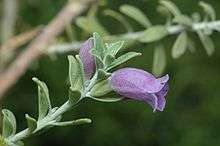Eremophila resinosa
| resinous eremophila | |
|---|---|
 | |
| Scientific classification | |
| Kingdom: | Plantae |
| (unranked): | Angiosperms |
| (unranked): | Eudicots |
| (unranked): | Asterids |
| Order: | Lamiales |
| Family: | Scrophulariaceae |
| Genus: | Eremophila |
| Species: | E. resinosa |
| Binomial name | |
| Eremophila resinosa (Endl.) F.Muell.[1] | |
| Synonyms[2] | |
Eremophila resinosa, also known as resinous eremophila, is a flowering plant in the figwort family, Scrophulariaceae and is endemic to Western Australia. It is a spreading shrub with sticky young foliage, short leaves, small sepals and mauve, purple or sometimes white flowers.
Description
Eremophila racemosa is a spreading shrub which grows to a height of between 0.4 and 1.0 m (1 and 3 ft) and a width of up to 1.0 m (3 ft). The branches have small, raised, amber-coloured, translucent lumps and a covering of fine, branched hairs. The leaves are lance-shaped to egg-shaped with the narrower end towards the base. They are 6–17 mm (0.2–0.7 in) long, about 2 mm (0.08 in) wide and have fine, branched hairs.[2][3][4]
The flowers are borne singly in leaf axils on stalks up to 1 mm (0.04 in) long. There are 5 overlapping, green, tapering, lance-shaped sepals which are 3–5.5 mm (0.1–0.2 in) long. The petals are 13–18 mm (0.5–0.7 in) long and are joined at their lower end to form a tube. They are mauve, purple or sometimes white and when coloured, appear lighter on the outside because of a covering of fine, branched hairs. The inside of the tube is often spotted. The inside surface of the petal lobes is glabrous but the inside of the tube is filled with long hairs. The 4 stamens are fully enclosed in the petal tube. Flowering occurs from May to September and the fruits which follow are dry, oval-shaped with a pointed end, slightly rough and about 4 mm (0.2 in) long.[2][3][4]
Taxonomy and naming
The species was first formally described in 1838 by Stephan Endlicher who gave it the name Pholidia resinosa. The description was published in Stirpium Australasicarum Herbarii Hugeliani Decades Tres.[5] In 1860, Ferdinand von Mueller changed the name to Eremophila resinosa and published the change in Papers and Proceedings of the Royal Society of Van Diemen's Land.[1][6] The specific epithet (resinosa) is a Latin word meaning "resinous".[7]
Distribution and habitat
Resinous eremophila grows in clay, gravelly and sandy soils in the wheatbelt north-east of Merredin in the Avon Wheatbelt biogeographic region.[8][2]
Conservation
Eremophila resinosa is listed as "Endangered" (EN) under the Environment Protection and Biodiversity Conservation Act 1999 (EPBC Act). As at April, 2008 it was only known from 26 natural populations and 1418 individual plants.[4] Five clones of the species were grown by tissue culture and planted at Westonia in 2004. Seed was also collected and grown at the same site. Survival rates are high for both the tissue cultured and seed-raised plants. To date, over 4,000 plants are growing and 2 million fruits are in long-term storage.[9][10]
Use in horticulture
This small shrub can bear masses of purple flowers in spring and its hardiness adds to its potential as a feature plant in a small garden. It is easily propagated from cuttings and grown in a wide range of soils, including clay in full or part shade. It is very drought tolerant, needing little or no watering, even during long droughts and tolerates the most severe frosts.[11]
References
- 1 2 "Eremophila resinosa". APNI. Retrieved 6 March 2016.
- 1 2 3 4 Chinnock, R.J. (Bob) (2007). Eremophila and allied genera : a monograph of the plant family Myoporaceae (1st ed.). Dural, NSW: Rosenberg. pp. 462–464. ISBN 9781877058165.
- 1 2 Brown, Andrew; Buirchell, Bevan (2011). A field guide to the eremophilas of Western Australia (1st ed.). Hamilton Hill, W.A.: Simon Nevill Publications. p. 237. ISBN 9780980348156.
- 1 2 3 Douglas, Craig; Johnston, Wendy; Jolliffe, David. "Resinous Eremophila (Eremophila resinosa) Recovery Plan" (PDF). Government of Western Australia, Department of Environment and Conservation. Retrieved 6 March 2016.
- ↑ "Pholidia resinosa". APNI. Retrieved 6 March 2016.
- ↑ von Mueller, Ferdinand (1859). "On the genus Eremophila". Papers and Proceedings of the Royal Society of Van Dieman's Land. 3: 296. Retrieved 6 March 2016.
- ↑ "resinosus". Wiktionary. Retrieved 6 March 2016.
- ↑ "Eremophila resinosa". FloraBase. Western Australian Government Department of Parks and Wildlife.
- ↑ Soorae (ed.), Pritpal S.; Dixon, Bob (2010). Translocation of the resinous Eremophila from test tube to degraded bushland site in the wheatbelt of Western Australia. Abu Dhabi, UAE: IUCN/SSC Re-introduction Specialist Group & Environment Agency - Abu Dhabi. pp. 311–315. ISBN 9782831713205.
- ↑ "Eremophila translocation". Kings Park Botanic Gardens and Parks Authority. Retrieved 6 March 2016.
- ↑ Boschen, Norma; Goods, Maree; Wait, Russell (2008). Australia's eremophilas : changing gardens for a changing climate. Melbourne: Bloomings Books. p. 220. ISBN 9781876473655.
